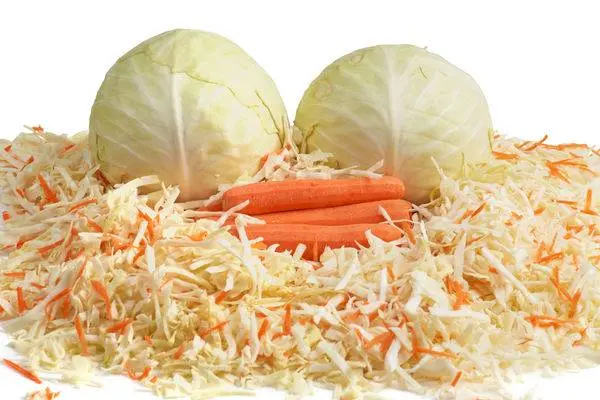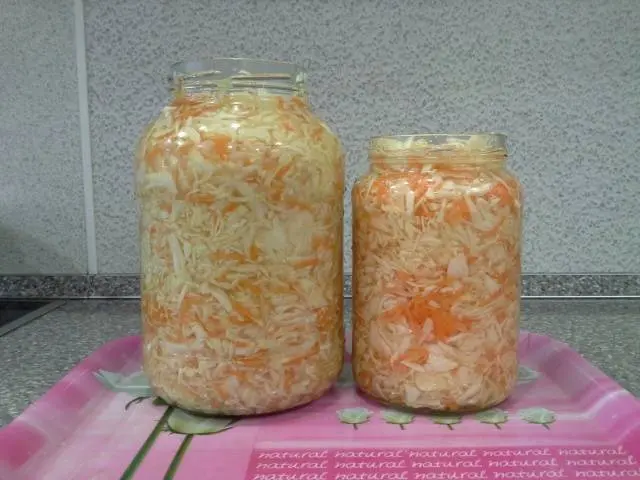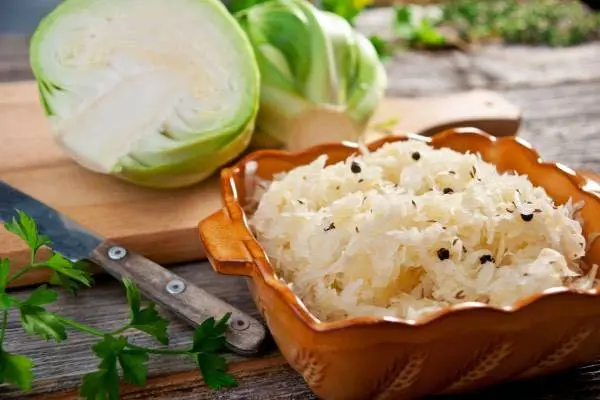Contents
Delicious sauerkraut must be crispy, but not every housewife knows how to achieve the desired result. And only professionals can share some of the important secrets of making winter pickles. We will try to talk about them in detail later in the article. The suggested tips and tricks will certainly be useful for beginners and already experienced chefs.

Little tricks – the key to successful salting
Every year, with the advent of autumn, the question of how to salt crispy cabbage for the winter becomes relevant. There can be no unambiguous answer to this question, since the fermentation process is quite delicate and even, at first glance, an insignificant factor can adversely affect the preservation and souring of cabbage. So, deciding to prepare sauerkraut for the winter, you need to consider the following important points:
Variety choice
For pickling, cabbage is suitable only for medium-early and late varieties. Such heads are always dense, juicy, large, contain a large amount of sugar, which is actively involved in the fermentation process. Such cabbage can be stored fresh for a long time under certain temperature conditions. The storage period of some varieties is 6, and sometimes 8 months. The sourdough also extends the shelf life: Properly cooked sauerkraut can be stored until the next season.
Among all the variety, such varieties of cabbage as Slava, Valentina, Gift and some others are recognized as the best for salting and long-term winter storage.

When choosing cabbage for pickling, it is necessary to pay attention to the external characteristics of the cabbages: when compressed, a fresh, ripe vegetable should spring slightly. The weight of the head of cabbage should be at least 3 kg, and on its surface there should be as few green and damaged leaves as possible. They are unsuitable for sourdough and, in fact, will be production waste. Vegetables with cracks, signs of spoilage or rotting are not suitable for sourdough.
Important Cooking Rules
In order for salted cabbage to be tasty and crispy, you must not only use a proven recipe, but also follow certain cooking rules:
- It is recommended to ferment cabbage in a glass, plastic or enameled container. Having chosen an enameled container, you need to carefully inspect it for internal chips and scratches. Containers with internal damage are not suitable for sourdough cabbage. The best option for sourdough may be an oak barrel, but it is not always possible to find one. Do not use iron or aluminum containers for souring. The contact of an acidic vegetable with a metal will contribute to a change in the taste of the product.
- In the cooking process, use only clean tools and utensils. For some, this rule may seem banal, but often it is the presence of “foreign” bacteria that leads to the fact that the cabbage is fermented incorrectly and its taste becomes obscene as a result. You can achieve purity of preparation with the help of saline (1 tablespoon of salt per 1 liter of boiling water) or an alcohol solution. The culinary specialist must treat the cutting board, knife, and fermentation container with a disinfectant.
- Iodized salt is not suitable for making pickled snacks or any other winter preparations. For these purposes, it is better to use ordinary rock salt. You can add a preservative to cabbage to taste, but in order for it to be crispy, it is recommended to add 1 tbsp. l. salt per 1 kg of finished product.
- Cabbage should be cut into approximately equal slices, 0,5-0,6 mm wide. Smaller cuts will destroy many vitamins, and large pieces may not be salted enough or unevenly.
- With the dry sourdough method, the cook must knead the shredded cabbage so that it releases the juice. In this case, it is important not to overdo it, because too soft cabbage cannot become crispy when fermented. So, experienced housewives recommend only a few clicks on a pre-salted vegetable. After such a manipulation, you need to tightly tamp the product into a container so that the juice completely covers it.
- As a result of fermentation, sauerkraut emits an unpleasant odor, which is caused by carbon dioxide. The resulting gases must be removed from the thickness of the prepared product. To do this, pierce fermenting vegetables with a knitting needle, skewer or knife that can reach the bottom of the container. It is necessary to remove gases in this way 2-3 times a day. If this is not done, then the product will be bitter, unpleasantly smelling, slimy.
- Cabbage should be fermented at room temperature for 3-4 days. The exact fermentation time depends on the specific conditions, the composition of the product, and the taste preferences of the hostess. As soon as the cabbage has acquired the desired taste, it must be “hidden” in a cool place where the fermentation process will stop.

Our ancestors harvested sauerkraut in huge volumes every year. They believed that the product prepared for the growing moon would definitely turn out tasty and crispy. Also, according to legend, the key to success in cooking lies in the good mood of the cook. Perhaps modern housewives who decide to ferment cabbage will also be useful to look into the lunar calendar and exchange jokes with their loved ones.
Optimal souring conditions
When the cabbage is moderately sour, you need to take care of its safety. The optimal condition for storing the finished product is a temperature of -2- +20C. You can “find” such a microclimate in a refrigerator or on a balcony in winter. It is convenient to store sauerkraut in a 3-liter jar. A tightly packed product does not lose juice and does not absorb foreign odors.

You can freeze the product only once.
The best recipes for crispy sauerkraut
Most often, housewives cook sauerkraut according to the traditional recipe with carrots, salt and sugar. Cumin, dill seeds, or other spices can add flavor to winter harvests. A snack fermented with beets, apples or fresh berries of lingonberries, cranberries, mountain ash has a bright color and unusual taste.
Easy crunchy snack recipe
For novice cooks, the classic sauerkraut recipe may be the best. To implement it, you will need the main vegetable, carrots, salt and sugar. Carrots contain a lot of natural sugar, which will also contribute to active fermentation. The bright color of the carrots will make the appearance of the snack even fresher and more appetizing. Carrots are recommended to be added in an amount of 10% by weight of the main vegetable.
If it is decided to ferment the product in a 3-liter jar, then you need to calculate for 4 kg of cabbage. It is this amount of shredded vegetables that can fit in the specified volume. Additionally, you need to use 400 g of carrots, 3-4 tbsp. l. salt and 2 tbsp. l. Sahara. It is worth noting that with sourdough you can do without sugar at all. In this case, the taste of the snack will be less bright, and the fermentation process itself will take a little longer.

To understand exactly how to pickle cabbage, you can familiarize yourself with the following sequence of work:
- Remove the top green and damaged leaves from the heads. Divide the vegetable into 4 parts.
- Finely chop the cabbage. Sprinkle each 1 kg of crushed product with a spoonful of salt and lightly knead.
- Peel, wash and grate carrots. You can grind carrots on a regular grater or a Korean salad grater.
- After preparing the main vegetable, mix all the ingredients thoroughly and put them tightly in a 3-liter jar or other container.
- In the jar, you need to leave some free space where the juice will accumulate. During the fermentation process, the juice will actively stand out, so it is better to put the jar on a plate.
- In the process of souring, the resulting gases must be released from the thickness of sauerkraut.

Dill seeds, cumin, or fresh berries can be included in this simple recipe. By strictly observing the proposed algorithm of action and the above general cooking rules, each housewife will be able to quickly cook delicious, crispy sauerkraut for the winter for her family. As soon as the entire volume of the workpiece is eaten, you can again take care of preparing a pickled snack, because you can always buy several kilograms of fresh vegetables in the store.
Sauerkraut with apples and cumin
Cabbage and apples are a real vitamin bomb, especially when it comes to sauerkraut. Among all the recipes based on such a combination of vegetable and fruit, one can single out the Bavarian version of making pickled snacks. It includes the main vegetable in the amount of 3,5 kg, three medium-sized apples, 2-3 carrots and 3 tbsp. l. cumin, 2-3 tbsp. l. salt. If desired, juniper berries can also be included in the composition.
Cooking such sauerkraut has some secrets:
- Before cooking, cumin seeds must be heated in a frying pan (dry). The heated spice needs to be slightly ground, which will enhance its taste.
- Grind the main vegetable and carrots as usual, and cut the apple into thin slices.
- Caraway seeds, salt the cabbage and lightly knead. Add the rest of the ingredients to the mixture.
- Fold the mixture of products tightly into a container and press it with oppression. Ferment for several days at room temperature, periodically releasing gases from the thickness of the vegetable blank, then place the product in the cold.

Conclusion
In the preparation of sauerkraut according to any of the proposed recipes, you must follow the general algorithm of actions that will allow the products to ferment actively and correctly. To choose the best cooking recipe, from the whole variety of ideas, you need to be based on personal preferences.
As one of the options, you can consider the recipe shown in the video:
Natural sauerkraut with carrots and possible other ingredients will always be on the table, and will be an indispensable source of vitamins all winter. It is thanks to the wonderful taste and usefulness that the relevance of cooking sauerkraut has been preserved from ancient times to the present day.









